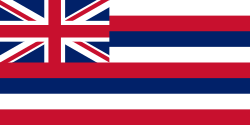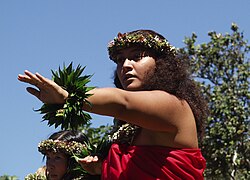
The following outline is provided as an overview of and topical guide to the U.S. state of Hawaii:
Contents
- General reference
- Geography of Hawaii
- Environment of Hawaii
- Demography of Hawaii
- Government and politics of Hawaii
- Branches of the government of Hawaii
- Law and order in Hawaii
- Military in Hawaii
- History of Hawaii
- History of Hawaii, by period
- History of Hawaii, by region
- History of Hawaii, by subject
- Culture of Hawaii
- The Arts in Hawaii
- Religion in Hawaii
- Economy and infrastructure of Hawaii
- Education in Hawaii
- See also
- References
- External links
Hawaii is the newest state among the 50 states of the United States of America. It is also the southernmost state, the only tropical state, and the only state that was previously an independent monarchy.
The state comprises the Hawaiian Islands (with the exception of Midway) in the North Pacific Ocean and is the only U.S. state that is not primarily located on the continent of North America.





















